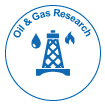Sustainable Development in Low Carbon, Cleaner and Greener Energies
*Corresponding Author:
Copyright: © 2020 . This is an open-access article distributed under the terms of the Creative Commons Attribution License, which permits unrestricted use, distribution, and reproduction in any medium, provided the original author and source are credited.
Abstract
Carbone dioxide flooding has been applied worldwide as a successful enhanced oil recovery. Carbone dioxide flooding may be applied as a continuous injection or as water alternating gas (WAG) process. Optimization of the injection mode of carbon dioxide is important for economical field application. This paper focuses on using a fully compositional simulation model for “AEB-3C” sandstone oil reservoir; in one of the Western Desert oil fields in Egypt; to predict the impact of CO2 miscible flooding on the reservoir oil recovery and net present value (NPV), to define the best mode of operation that is straight CO2 injection or water alternating gas (WAG) processes and to show the difference between pure and impure CO2. Moreover, several sensitivity runs were done on the oil price to show minimum profitable value of oil price when applying such a tertiary method in the subject field.The reservoir under study has been producing under a successful water flooding project since May2010. The recovery factor by the end of water flooding project is predicted as 32%. CO2 flooding processes have started by the end of water flooding. The used CO2 is taken from the flared gas (which containing 75% CO2 of its composition) of the nearest gas plant (12 km away).

 Spanish
Spanish  Chinese
Chinese  Russian
Russian  German
German  French
French  Japanese
Japanese  Portuguese
Portuguese  Hindi
Hindi 


